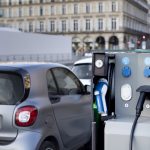Smart Cities Need Intelligent Infrastructure Powered by Smart Energy
The rollout of smart cities is well underway, however, to make a city truly smart all the individual elements need to work together, not just independently. Connecting these elements is the infrastructure which, like the IoT devices themselves, are full of sensors but with their own challenges to ensure they work successfully. These may be motion sensors, pollution sensors, parking sensor or moisture sensors to name just a few, and all require safe, reliable and energy efficient power.
Imagine traveling into a smart city in your autonomous car. With connected devices controlling the car and city, you can sit back and relax. But behind the scenes, there is a lot going on to make this possible. Lots of sensors are working flat out in both the city and car, to ensure everything runs smoothly. The car sensors ensure it can read reference points like roadworks, parking, and smart traffic lights. These, in turn, are full of sensors that can read the arrival of autonomous and non-autonomous cars. They gather data on vehicle movement and quantity to ensure smooth traffic flow through the city – safe and efficient movement being a key benefit of IoT smart cities.
On public transport, sensors on the rail tracks monitor where the trains are at all times ensuring smoother running of the trains and more up-to-date information for the passengers. In addition, sensors enable remote condition monitoring of tracks and points collecting data that will flag problems and maintenance issues before they become costly to repair.
Lampposts in a smart city not only light the streets but also provide the opportunity for city management to monitor them. The EU program Sharing Cities is trialing smart city technology in various European cities. They state Europe’s existing lighting network costs €3 billion a year to operate. Installing smart street lighting could reduce electricity costs to €900 million.
Sensors on lampposts can detect movement so they only light when required thus providing cost and energy savings. Sensors will also provide maintenance and fault detection data in advance so engineers will only need to visit a particular lamppost when it needs maintenance rather than on a scheduled health check routine.
Smart energy management and smart building technology are also on the rise with a predicted increase of approx. 30% a year. Buildings are becoming more complex with interconnected IoT systems offering energy and cost-efficient buildings. IoT infrastructures are being developed to offer many benefits, including optimizing room occupancy, turning lights on/off as needed, monitoring assets movement and thus increasing security by knowing where people are located.

However, these automated systems will have more complex infrastructure requiring more communication technologies and wiring. Sensors will monitor the health of the building, providing predictive maintenance data. Especially in the case of retrofitting existing buildings, these can be in hard to reach locations creating their own set of challenges.
A smart city will also have elements outside the city. To ensure its population has safe, clean drinking water, wastewater, and water treatment plants will benefit from increased sensing and communication technology adoption. Sensors at these facilities will remotely monitor a range of equipment (such as water composition control testers), sending data back to a central control point. It’s not feasible to have engineers at each location full-time on the off chance there’s a problem and the time and expense of them proactively driving round to the different locations is both costly and inefficient.
So whilst it’s clear that smart cities offer many benefits, a major challenge is making it happen to reap the full benefits. Just thinking about each individual IoT device doesn’t work. We need to think about the infrastructure connecting the whole smart city and how it’s installed and maintained. Key to this is powering all the sensors that will be required in the infrastructure. If the sensors required keep powering down and need constant maintenance the city will never be truly smart. City officials don’t want to incur costs of frequently sending out engineers to change batteries powering the ever increasing number of sensors. They need a form of power that is as smart and intelligent as the devices being powered.
Cabling power to the sensors is costly and often impractical. Installing batteries can also be difficult as sensors can be located in hostile conditions where they need to function despite high temperatures, dust, oil and vibration. Smart lampposts need to be powered in an energy and cost efficient way that can handle the intense heat from the bulbs. Batteries powering sensors on rail tracks need to function despite being located in dirty, hot environments covered in oil and dust. Autonomous vehicles will have so many sensors cabling isn’t feasible as the weight of the cabling required will be too great. This is especially key as there are global environmental targets to lower the weight of cars in order to make them more efficient and environmentally friendly. Batteries need to be lightweight, able to work in high temperatures.
In addition, they need to power the sensors for a long time as frequently changing the batteries can be very expensive negating the cost benefits of a smart city. One of the main goals of intelligent cities and buildings are to be more cost, energy and time efficient. A smart city isn’t smart if the elements that make it smart keep powering down.
Traditional batteries don’t have the lifespan required and vibrations can cause dangerous leakages. Some batteries can handle extreme temperatures but these are often large and heavy. Fortunately, battery technology innovation has moved forward. Solid state batteries are designed for powering wireless sensors in connected IoT devices. They offer:
- Long lifespan up to 10 years with minimal maintenance
- Efficient in hostile environments with extreme temperatures or humidity
- Non-flammable
- Scalable size from miniature to large scale
- Increased energy density
Smart cities need intelligent infrastructure to become truly smart and as invisible as possible. Infrastructure with ‘Fit and Forget’ powering that is safe, reliable and long lasting is vital to making this a reality. Then not only will all the connected devices work effectively and efficiently but will also produce accurate data that will be used to make the city even smarter. Solid state batteries offer the power required to make this happen.
 This article was written by Denis Pasero of Ilika Technologies, a pioneer in solid-state battery technology. Denis joined Ilika in 2008, as a scientist specializing in battery technology, to manage commercial lithium-ion projects. Today, as Product Commercialization Manager, Denis interfaces between customers and technical teams.
This article was written by Denis Pasero of Ilika Technologies, a pioneer in solid-state battery technology. Denis joined Ilika in 2008, as a scientist specializing in battery technology, to manage commercial lithium-ion projects. Today, as Product Commercialization Manager, Denis interfaces between customers and technical teams.



